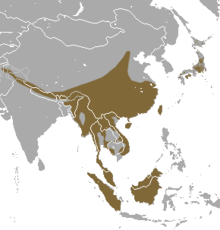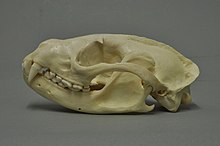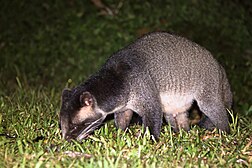Masked palm civet
| Masked palm civet | |
|---|---|

| |
| Scientific classification | |
| Domain: | Eukaryota |
| Kingdom: | Animalia |
| Phylum: | Chordata |
| Class: | Mammalia |
| Order: | Carnivora |
| Suborder: | Feliformia |
| Family: | Viverridae |
| Subfamily: | Paradoxurinae |
| Genus: | Paguma Gray, 1831 |
| Species: | P. larvata[1] |
| Binomial name | |
| Paguma larvata[1] | |

| |
| Masked palm civet range | |
The masked palm civet (Paguma larvata), also called the gem-faced civet or Himalayan palm civet, is a viverrid species native to the Indian subcontinent and Southeast Asia. It has been listed as least concern on the IUCN Red List since 2008 as it occurs in many protected areas, is tolerant to some degree of habitat modification, and widely distributed with presumed large populations that are unlikely to be declining.[2]
The genus Paguma was first named and described by John Edward Gray in 1831. All described forms are regarded as a single species.[4]
In 2003, masked palm civets at a wildlife market in China were found to have been infected with the severe acute respiratory syndrome coronavirus.[5]
Characteristics

The masked palm civet's fur is grayish to ochraceous, black on the head, shoulders and neck, and blackish brown on the tail and feet. It has a white blaze on the forehead; white marks above and below the eyes extend to the ears, forming a half-collar.[6] In morphology the masked palm civet resembles other palm civets, but does not have spots or stripes. Its tail is more than two-thirds the length of head and body. It has two pairs of mammae.[7]
The whitish mask extends laterally to the far edges of the cheeks and caudally up the forehead, past the ears, and down the back of the neck before stopping just under the shoulder blades. The eyes are surrounded by white fur that can vary from faint, incomplete outlines to well-defined blotches. The lips, chin, and throat are white. In some, white stripes of fur, comparable to sideburns on humans due to shape and location, curve up from the throat. These curves vary in thickness and have ends that terminate either in small blotches at the ear base or large blotches that surround the base of both darkly furred ears.[8]
The species having a large repartition, differences in morphological parameters can be observable in different populations. Adults of this species usually have a body length of 50 to 60 cm (20 to 24 in), a tail measuring 40 to 50 cm (16 to 20 in) and a weight between 3 and 5 kg (6.6 and 11.0 lb), although some adults can be lighter or heavier (see table below).
| Attribute | Japan (Kase et al., 2011) (Females; n = 4)[9] | Japan (Kase et al., 2011) (Males; n = 2)[9] | China (Zhou et al., 2014) (Females; n = 17)[10] | China (Zhou et al., 2014) (Males; n = 16)[10] | Thailand (Chutipong et al., 2015) (Females; n = 2)[11] | Thailand (Chutipong et al., 2015) (Males; n = 1)[11] |
|---|---|---|---|---|---|---|
| Weight (kg) | 2.5–3.3 | 2.9–3.4 | 4.20 | 4.24 | 3.4–5.2 | 6.2 |
| Total Length (cm) | 94.0–101.0 | 99.0–102.0 | - | - | - | - |
| Head-Body Length (cm) | 53.0–58.0 | 56.0–57.0 | 53.60 | 53.88 | - | - |
| Tail Length (cm) | - | - | 47.89 | 48.68 | - | - |
Distribution and habitat
The masked palm civet is distributed from the northern parts of the Indian subcontinent, especially the Himalayas, ranging eastwards across Bhutan, Bangladesh, Myanmar, Thailand, Peninsular Malaysia, Laos, Cambodia, Vietnam to China, Borneo, Sumatra, Taiwan, and the Andaman and Nicobar islands. It was introduced to Mainland Japan and Ryukyu Islands.[2] It has been recorded in both evergreen and deciduous forest, and in disturbed habitat.[12] It also inhabits fragmented forest habitats, albeit at reduced density.[2]
It is also found in Japan, where genetic studies indicate that it is an introduced species with multiple introductions over the centuries, at least two of which are from Taiwan.[13]
Ecology and behaviour
The masked palm civet is a nocturnal solitary predator that is occasionally active during the day.[12][14][15] It is partly arboreal.[16]
When alarmed, the animal sprays a secretion from its anal gland against the predator. The spray is similar in function to that of a skunk, and its conspicuousness serves to deter other predators.[17][18]

Feeding and diet
The masked palm civet is an omnivore feeding on rats and birds as well as on fruit such as figs, mangoes, bananas, and leaves.[16] Scat analysis indicates that they also eat mollusks, arthropods, bark and to a lesser extent snakes and frogs. The composition of the diet varies between seasons and sites.[19]
Reproduction
Masked palm civets are polyestrous and their mating behavior is promiscuous.[10] There are two breeding seasons per year. The female bears up to four young. Masked palm civets are known to reach 15 years of age in captivity.[16]
Copulation in masked palm civets can last for more than 30 minutes.[20] Upon completion of copulation, males leave a copulation plug in the female's vaginal tract. The young grow to the size of an adult in about three months.[21]
Threats

The major threats for the masked palm civet are continued habitat destruction and hunting for bushmeat. It is widely offered in restaurants in southern China and is also eaten in Vietnam.[2] Masked palm civets are often victims of illegal animal trafficking to meet the demands in China and Vietnam; 100 civets were confiscated in April 2021. Despite relocation to Save Vietnam Wildlife, a wildlife rehabilitator, at least 8 civets died due to stress and injuries.[22]
Conservation
Paguma larvata is protected in Malaysia and China, but not Thailand and Nepal. The population of India is listed on CITES Appendix III.[2]
Connection with SARS
In May 2003, the SARS virus was isolated in several masked palm civets found in a wildlife market in Guangdong, China. Evidence of virus infection was also detected in other animals including a raccoon dog, and in humans working at the same market.[23] In 2006, scientists from the Chinese Centre for Disease Control and Prevention of the University of Hong Kong and the Guangzhou Centre for Disease Control and Prevention established a direct genetic link between the SARS coronavirus appearing in civets and humans, bearing out claims that the disease had jumped across species.[24]
See also
References
- ^ Wozencraft, W. C. (2005). "Species Paguma larvata". In Wilson, D. E.; Reeder, D. M. (eds.). Mammal Species of the World: A Taxonomic and Geographic Reference (3rd ed.). Johns Hopkins University Press. p. 550. ISBN 978-0-8018-8221-0. OCLC 62265494.
- ^ a b c d e f Duckworth, J.W.; Timmins, R.J.; Chutipong, W.; Choudhury, A.; Mathai, J.; Willcox, D.H.A.; Ghimirey, Y.; Chan, B.; Ross, J. (2016). "Paguma larvata". IUCN Red List of Threatened Species. 2016: e.T41692A45217601. doi:10.2305/IUCN.UK.2016-1.RLTS.T41692A45217601.en. Retrieved 19 November 2021.
- ^ Smith, C.H. (1827). "Gulo larvatus, the Masked Glutton". In Griffith, E. (ed.). The animal kingdom : arranged in conformity with its organization. Vol. 2. Mammalia. London: G.B. Whittaker. p. 281.
- ^ Pocock, R. I. (1939). "Genus Paguma Gray". The Fauna of British India, Including Ceylon and Burma: Mammalia Volume 1. London: Taylor and Francis. pp. 415–430.
- ^ Xiao, Y.; Meng, Q.; Yin, X.; Guan, Y.; Liu, Y.; Li, C.; Wang, M.; Liu, G.; Tong, T.; Wang, L.F. & Kong, X. (2008). "Pathological changes in masked palm civets experimentally infected by severe acute respiratory syndrome (SARS) coronavirus". Journal of Comparative Pathology. 138 (4): 171–179. doi:10.1016/j.jcpa.2007.12.005. PMC 7094611. PMID 18343398.
- ^ Allen, G. M. (1938). "Genus Paguma Gray. The Masked Civets". The mammals of China and Mongolia. Vol. 1. New York: American Museum of Natural History. pp. 433–440.
- ^ Pocock, R. I. (1939). "Genus Paguma Gray". The Fauna of British India, Including Ceylon and Burma. Vol. Mammalia Volume 1. London: Taylor and Francis. pp. 414–430.
- ^ "Masked palm civet". Project Noah. Retrieved 17 April 2021.
- ^ a b Kase, Chihiro; Eguchi, Yusuke; Furuya, Masuo; Uetake, Katsuji; Tanaka, Toshio (2011). "The effect of body size on shapes and sizes of gaps entered by the masked palm civet (Paguma larvata)". Mammal Study. 36 (3): 127–133. doi:10.3106/041.036.0302. S2CID 86291383. Retrieved 25 January 2023.
- ^ a b c Zhou, Y.; Newman, C.; Palomares, F.; Zhang, S.; Xie, Z.; Macdonald, D. W. (2014). "Spatial organization and activity patterns of the masked palm civet (Paguma larvata) in central-south China". Journal of Mammalogy. 95 (3): 534–542. doi:10.1644/13-MAMM-A-185. PMC 7107440. PMID 32287381.
- ^ a b Chutipong, Wanlop; Steinmetz, Robert; Savini, Tommaso; Gale, George A. (2015). "Sleeping site selection in two Asian viverrids: effects of predation risk, resource access and habitat characteristics" (PDF). Raffles Bulletin of Zoology. 63. National University of Singapore: 516–528. Retrieved 25 January 2023.
- ^ a b Grassman Jr., L. I. (1998). "Movements and fruit selection of two Paradoxurinae species in a dry evergreen forest in Southern Thailand". Small Carnivore Conservation. 19: 25–29.
- ^ Inoue, Tomo; Kaneko, Yayoi; Yamazaki, Koji; Anezaki, Tomoko; Yachimori, Shuuji; Ochiai, Keiji; Lin, Liang-Kong; Pei, Kurtis Jai-Chyi; Chen, Yen-Jean; Chang, Shih-Wei; Masuda, Ryuichi (4 May 2012). "Genetic population structure of the masked palm civet Paguma larvata, (Carnivora: Viverridae) in Japan, revealed from analysis of newly identified compound microsatellites". Conservation Genetics. 13 (4): 1095–1107. Bibcode:2012ConG...13.1095I. doi:10.1007/s10592-012-0357-7. S2CID 18211121. Retrieved 22 September 2017.
- ^ Rabinowitz, A. R. (1991). "Behaviour and movements of sympatric civet species in Huai Kha Khaeng Wildlife Sanctuary, Thailand". Journal of Zoology. 223 (2): 281–298. doi:10.1111/j.1469-7998.1991.tb04765.x.
- ^ Than Zaw; Saw Htun; Saw Htoo; Tha Po; Myint Maung; Lynam, A. J.; Kyaw Thinn Latt; Duckworth, J. W. (2008). "Status and distribution of small carnivores in Myanmar". Small Carnivore Conservation (38): 2–28.
- ^ a b c Lekagul, B. and McNeely, J. A. (1988). Mammals of Thailand. White Lotus Press, Bangkok, Thailand.
- ^ Lundrigan, B; Baker, S (2003). "Paguma larvata". Animal Diversity Web. Retrieved 8 November 2023.
- ^ "CẦY VÒI MỐC P. larvata". Save Vietnam's Wildlife. 8 April 2022. Retrieved 8 November 2023.
- ^ Zhou, Y.; Zhang, J.; Slade, E.; Zhang, L.; Palomares, F.; Chen, J.; Wang, X.; Zhang, S. (2008). "Dietary shifts in relation to fruit availability among masked palm civets (Paguma larvata) in central China". Journal of Mammalogy. 89 (2): 435–447. doi:10.1644/07-MAMM-A-048R1.1. PMC 7542873. PMID 34191878.
- ^ Jia, Z.-Y.; Jiang, Z. G.; Wang, Z.-W. (2001). "Copulatory behavior in captive masked palm civets, Paguma larvata". Folia Zoologica. 50 (4): 271–278.
- ^ Jia, Z.; Enkui Duan; Zhigang Jiang; Zuwang Wang (2002). "Copulatory plugs in Masked Palm Civets: Prevention of semen leakage, sperm storage, or chastity enhancement?". Journal of Mammalogy. 83 (4): 1035–1038. doi:10.1644/1545-1542(2002)083<1035:cpimpc>2.0.co;2.
- ^ "100 CONFISCATED CIVET INDIVIDUALS NEED YOUR URGENT HELP!". SVW – Save Vietnam's Wildlife. Archived from the original on 23 April 2021. Retrieved 23 April 2021.
- ^ Guan, Y.; Zheng, B.J.; He, Y.Q.; Liu, X.L.; Zhuang, Z.X.; Cheung, C.L.; Luo, S.W.; Li, P.H.; Zhang, L.J.; Guan, Y.J.; Butt, K.M.; Wong, K.L.; Chan, K.W.; Lim, W.; Shortridge, K.F.; Yuen, K.Y.; Peiris, J.S. & Poon, L.L. (2003). "Isolation and characterization of viruses related to the SARS coronavirus from animals in southern China". Science. 302 (5643): 276–278. Bibcode:2003Sci...302..276G. doi:10.1126/science.1087139. PMID 12958366. S2CID 10608627.
- ^ Quanlin, Q. (2006). "Scientists prove SARS-civet cat link". China Daily.
External links
 Media related to Paguma larvata at Wikimedia Commons
Media related to Paguma larvata at Wikimedia Commons

